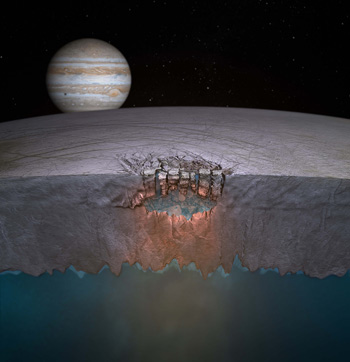We’ve known for years that Jupiter’s moon Europa almost certainly has an ocean of liquid water deep under its frozen surface. For one thing, the surface is almost all water ice. We also know that it’s covered in thousands of cracks that look very much like the type we see in ice floes floating on liquid water here on Earth. And we have a heating mechanism: tides from Jupiter as well as from the other moons flex Europa, causing its interior to warm up.
A nagging question has been how thick is the solid ice shell over that ocean: is it many kilometers thick, or much thinner? Evidence supports both arguments, which is maddening. However, that problem may now be solved: astronomers studying Europa’s terrain think the ice shell is generally very thick, but – and this is the cool part – may have vast underground lakes of water!
This picture is from observations of Europa made by the Galileo spacecraft, which orbited Jupiter for many years. It’s a combination of optical images and photoclinometry – using pictures to measure the heights of surface features. Purple and red is elevated terrain, and you can see that this looks like a depression in the surface. It’s filled with what’s called “chaotic terrain” for obvious reasons. Most of the surface of Europa has larger scale structure, and is more organized, as you might expect from a thick shell of ice. But these smaller regions are a mess, and it looks like this is from pockets of liquid water under the surface, giant lakes the size of North America’s Great Lakes, completely buried in the ice.
 This artist’s view shows how this works; the lake is completely embedded in the ice shell. In general, the ice is very thick, explaining the usual look of Europa’s surface. But in some spots, just below the ice, the ice has melted. The ice above this underground lake is much thinner, perhaps only 3 km (about 2 miles) thick, explaining the chaotic surface in those localized spots.
This artist’s view shows how this works; the lake is completely embedded in the ice shell. In general, the ice is very thick, explaining the usual look of Europa’s surface. But in some spots, just below the ice, the ice has melted. The ice above this underground lake is much thinner, perhaps only 3 km (about 2 miles) thick, explaining the chaotic surface in those localized spots.
That’s pretty nifty, but why is this so important? We know that on Earth, water is an essential ingredient for life. And we’ve known Europa has a lot of liquid water! But it’s locked under that thick shell. On the surface, sunlight has helped produce chemicals that are needed for biology, but there’s no way for them to get beneath that ice… or so we thought. The thinner ice above the lakes makes it possible for those chemicals to get below the surface, into the waters below. From there, various processes can get it down into the ocean itself.
And, just as interesting, the shape of the features above the spot pictured above (called Macula Thera) indicate the lake is still forming. It’s an ongoing process! That means that even today, right now, the chemistry for biological life is being produced and delivered to the waters underneath Europa’s surface. Mind you, this does not mean there is definitely life there! But the circumstances for life to arise may be better than we thought before.
It’s worth noting that Enceladus, a moon of Saturn that’s very similar to Europa, has geysers of water erupting constantly from its south pole. There’s some argument over whether Enceladus has pockets of liquid water or a global subsurface ocean; perhaps these findings from Europa will help resolve that dilemma as well.
This is very exciting news. It shows that the conditions for life may exist elsewhere in the solar system, of course. But in my mind what’s more important is that it shows us that we need to broaden our view of where we might consider life to be. Europa has been a prime candidate since the 1980s at least – it’s what prompted Arthur C. Clarke to use it for his novel “2010” (and made into the movie) – but the actual process of how life might arise there has been a problem. Now we have an entirely new idea on how is may occur.
What else is out there? What have we missed? Only by exploring, by looking, will we know. That’s the promise of science, and its greatest use: we can find things out.
Image credits: Paul Schenk/NASA; Britney Schmidt/Dead Pixel VFX/Univ. of Texas at Austin
Related posts:
- Life’s cauldron may be bubbling underneath Enceladus
- Enceladus does and does not have a global ocean
- The Galilean Revolution, 400 years later